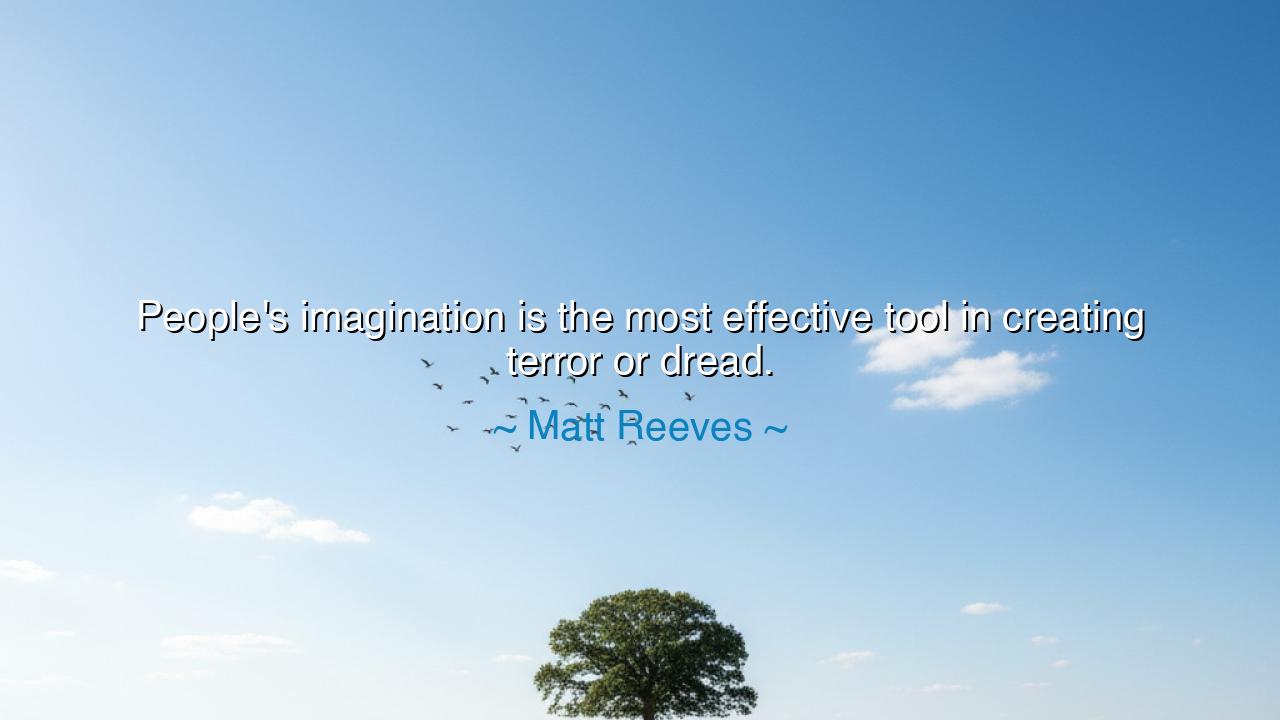
People's imagination is the most effective tool in creating






“People’s imagination is the most effective tool in creating terror or dread.” Thus spoke Matt Reeves, a maker of visions, who understood that the deepest fears do not dwell in shadows upon the wall, but within the uncharted chambers of the mind. His words are a mirror held to the soul, revealing a truth older than firelight and story: that the imagination, which gives birth to beauty and creation, can also summon phantoms of unspeakable power. For the terror that comes from within is greater than any the world can show without.
From the dawn of humankind, when the first fires were lit in the wilderness, fear was not born from what was seen, but from what was unseen. The rustle beyond the light, the howl in the distance — these were but the sparks that ignited the imagination, and the mind painted monsters upon the night. A man’s eyes might see only darkness, but his heart saw death. Thus, the ancients learned that the mind itself could be the greatest author of horror. They feared the unknown because it gave form to their own doubts, their guilt, and their longing for meaning in a world that offered none.
The storytellers of old understood this mystery well. Consider the myth of Pandora, who opened the forbidden jar. It was not merely the creatures within that terrified mankind, but the thought of what else might have been left unseen. When hope alone remained, even that was both comfort and curse — for the imagination of suffering is endless, yet the imagination of hope is its only cure. The Greeks, in their wisdom, taught that terror is not the work of gods, but of the human mind’s power to imagine what the gods might do.
In more recent days, this truth was reborn in art and story. When the filmmaker Alfred Hitchcock crafted Psycho, he revealed that what we do not see is far more dreadful than what we do. The knife glints for a moment, the scream pierces the air, and the rest — the blood, the violence, the death — lives entirely in the imagination of the audience. Each mind becomes its own executioner. Thus, Reeves’s words echo across time: fear is not in the monster’s face, but in the mind’s eye that gives it shape.
Yet this power, though dangerous, is not evil. The imagination is a double-edged sword — it is both the architect of dread and the fountain of courage. The same force that creates terror also creates wonder. The mind that envisions catastrophe can also dream of salvation. What makes imagination perilous is not its darkness, but our surrender to it. To master one’s imagination is to master fear itself; to let it run untamed is to be haunted by phantoms of one’s own making.
Consider the soldiers of old, who faced battle not yet begun but already lost within their thoughts. Many fell before the sword ever touched them, slain by terror born of imagination. Yet others stood firm, envisioning victory, brotherhood, and home. Their belief became their shield. Thus, imagination becomes the battleground of destiny — what we picture within becomes what we live without.
So take this lesson, O seeker of wisdom: beware the power of your imagination, for it can enslave or set you free. When fear rises, name it; when dread whispers, face it. Remember that what the mind creates, the heart can unmake. Feed your imagination not with shadows but with light, not with despair but with hope. For though imagination may be the most effective tool in creating terror, it is also the most divine gift in creating courage, compassion, and faith.
Therefore, walk wisely with your thoughts. Guard them as you would your home from fire. Let the imagination serve the spirit, not rule it. For in the end, it is not the monsters we invent that define us, but the dreams we dare to believe in.






AAdministratorAdministrator
Welcome, honored guests. Please leave a comment, we will respond soon